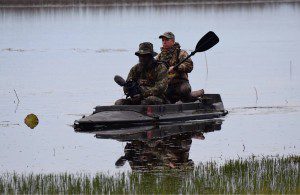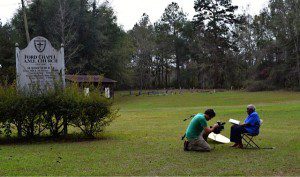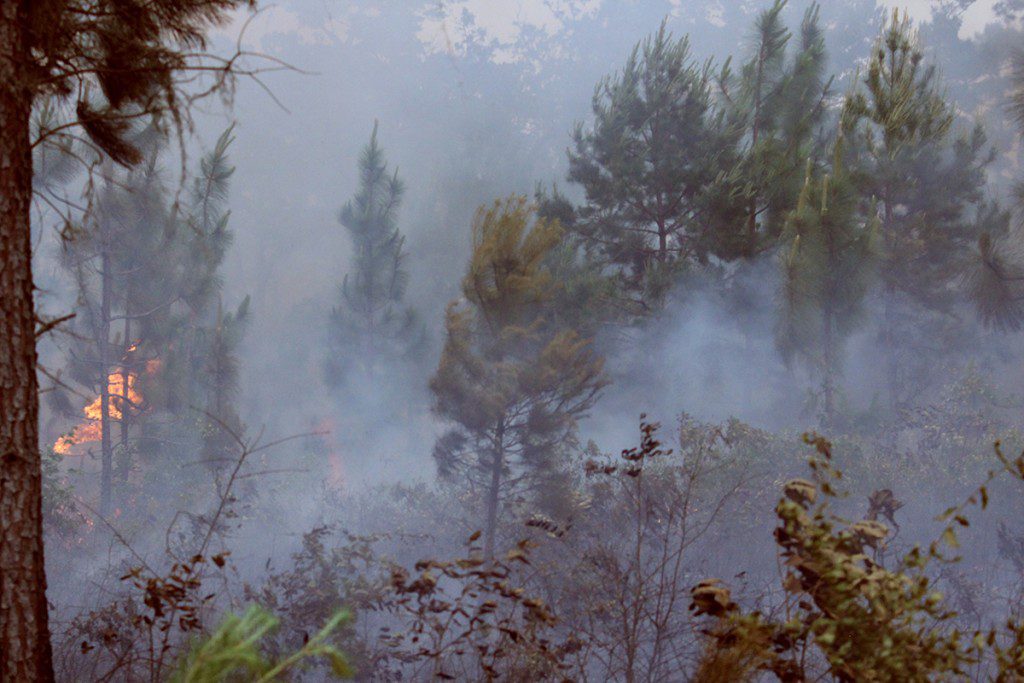Below is a quick preview of our upcoming series, Roaming the Red Hills. The segments will air in three installments on WFSU-TV’s Local Routes, starting on Thursday, March 31 at 7:30 pm ET. Meanwhile, here on the Ecology Blog we’ll take our usual deeper look at the places, people, and ecology featured in each segment. Thank you to Gary Asbell for stopping our kayak and grabbing his guitar to sing his song about the Ochlockonee River, which scores most of the promo below. You also hear a little bit of our Local Routes theme by Belle and the Band. Tallahassee’s Tracy Horenbein (a regular guest on our OutLoud show from 1999-2007) has composed original music for the series. Funding for Roaming the Red Hills was provided by Tall Timbers Research Station and Land Conservancy.
Rob Diaz de Villegas WFSU-TV

For a segment on duck hunting on Lake Iamonia, we met at 5 am, covered ourselves from head to toe in camouflage, and waited for ducks in the early morning sunlight. Photo credit, Georgia Ackerman, Tall Timbers Research Station and Land Conservancy.
Our mission: to capture the natural soul of the Red Hills region in ten short videos. To me, this is the best kind of project, hitting all of the geek centers in the brain associated with producing ecology videos. We see a 7-day-old endangered red cockaded woodpecker, featherless and reptilian, get banded. We kayak a rugged four mile stretch of Ochlockonee River, on the Georgia side, where we spend as much time climbing over logs as in the boat (and get serenaded along the way). We off road through a longleaf forest in a 100-year-old horse-drawn wagon, the wheels of which can only be repaired by the Pennsylvania Amish. And then there’s the thrill of running through a burning forest with a camera.
On Roaming the Red Hills, every shoot was distinctly different than the last. There’s a lot packed into this relatively small region hugging the border of Florida and Georgia.
The Red Hills is an upside down heart between Thomasville, Georgia and Tallahassee and Monticello in Florida. It’s bound by two rivers, the Aucilla in the east and Ochlockonee in the west, and by the ancient coastline of the Cody Escarpment to the south (it’s that little dip south of the fairgrounds in Tallahassee). It has a deep history sprouted from its fertile clay soils, large sinkhole lakes, two multiple personality rivers, and, of course, its unparalleled longleaf pine forests. Ten videos is only enough to give you a taste of what the region has to offer; what we had to do was find the tastiest bits to share (literally so when we head to Sweetgrass Dairy and Tupelo’s Bakery).

After interviewing her, WFSU Producer Rob Diaz de Villegas records Dr. Flossie Byrd reading from her book, Echoes of a Quieter Time, in front of Ford Chapel A.M.E. Church. Rob was intrigued by passages on learning to love Jefferson County because of its natural beauty and on the gravy used on coot hunted on Lake Miccosukee. This captured a sense of what it was to grow up with nature, a topic close to Rob’s heart. Photo credit: Georgia Ackerman, Tall Timbers.
We get to see some captivating landscapes, glorious sunrises, and an abundance of critters. But we also meet some great people as well. Dr. Flossie Byrd talked to us about pallbearer’s societies and gathering firewood before school in the historically black community of Junious Hill. Eluster Richardson took us through the creative process of painting his childhood experiences on a tenant farm. And, while on the Ochlockonee, we passed by Tallahassee lawyer Gary Asbell, who put down his fishing pole and grabbed a guitar to sing us a song he wrote about the river (you see that in the promo above).
And, of course, it’s important to me to get kids out in nature. We see them snorkeling and dragging nets in the Florida Ochlockonee in an attempt to see as many animal species as possible. At Birdsong Nature Center, they peep into gopher tortoise burrows with a specialized camera to see what’s living in them (hint: it’s not just gopher tortoises). And, in the Lost Creek Forest, we saw how native peoples would have made use of the plants and animals still available today in our local forests.
It can be easy to see a river as a weekend kayak destination, or longleaf forests as a good place for unpaved hiking trails. We did make an effort to experience the Red Hills as much as possible; and through that we uncovered the ways in which these ecosystems are woven into the fabric of our local history and culture. The canopy roads that wind through Dr. Byrd’s childhood haunts by Lake Miccosukee, and along Red Hills quail hunting plantations, are wonderful cycling trails. Outdoor adventures in the Red Hills provide great scenery, but there’s a depth to it. Every adventure brings us a little closer to understanding our regional identity.
I’m grateful to Tall Timbers Research Station and Land Conservancy’s Red Hills Initiative for providing the opportunity to roam this region in a manner similar to our exploration of estuary ecosystems on Florida’s Forgotten Coast. Like I mentioned earlier, ten videos is only a taste. We’ll have further adventures in the Red Hills, just as we’ve returned to the coast and just as we have continued to explore the Apalachicola watershed. And we have already had several EcoAdventures in the Red Hills and its surroundings. The most recent are a canoe adventure on the Aucilla River and a look at the many butterflies that make their home in the Red Hills.
Come adventure with us in the Red Hills, Apalachicola River and Bay, the Forgotten Coast, and More! Subscribe to the WFSU Ecology Blog by Email.
Banner image: WFSU videographer Brian Rochet tracks coots on Lake Miccosukee. Below: controlled burn at Tall Timber Research Station and Land Conservancy.

